|
|
|
Sort Order |
|
|
|
Items / Page
|
|
|
|
|
|
|
| Srl | Item |
| 1 |
ID:
047352
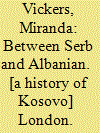

|
|
|
|
|
| Publication |
London, Hurst and Company, 1998.
|
| Description |
xix, 328p.pbk
|
| Standard Number |
1850653585
|
|
|
|
|
|
|
|
|
|
|
|
Copies: C:1/I:0,R:0,Q:0
Circulation
| Accession# | Call# | Current Location | Status | Policy | Location |
| 044857 | 949.71/VIC 044857 | Main | On Shelf | General | |
|
|
|
|
| 2 |
ID:
093765
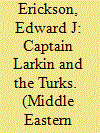

|
|
|
|
|
| Publication |
2010.
|
| Summary/Abstract |
The voyages of the HMS Doris along the Mediterranean coast near Alexandretta (modern Iskenderun, Turkey) in the winter of 1914-15 had a dramatic effect on the Ottoman Empire that far exceeded the scope of the operations. This article uses British, German, and Turkish archival sources to focus on the ship's operations in the vicinity of Dortyol and on the strategic impact these had on Ottoman perceptions of threats to the empire. The Doris figures prominently in two critical strategic outcomes - the relocation of the Armenians in 1915 and in the activation of three Ottoman army divisions for coastal defence and internal security.
|
|
|
|
|
|
|
|
|
|
|
|
|
|
|
|
| 3 |
ID:
188164
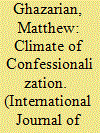

|
|
|
|
|
| Summary/Abstract |
After the 1877–78 Russo-Ottoman War, the Ottoman Empire saw the rise of ethnic and sectarian clashes in Anatolia, the Balkans, and elsewhere, and the task of explaining that rise remains unfinished. Many have examined the intellectual formations of ethnic and sectarian solidarities after 1878, but the availability of new ideas cannot alone account for their widespread uptake. Why after 1878 did ordinary people respond more to calls upon ethnic and sectarian solidarity? Drawing on sources surrounding the 1879 famine in the Ottoman East, this article steps away from imperial metropoles to examine overlapping environmental, financial, and technological disjunctures. Adopting the methods of political ecology, the article underscores the simultaneous effects of drought, sovereign default, and an influx of modern weapons, each of which imposed uneven hardships along ethno-religious lines. Together, they created a climate of lived confessionalization that highlighted the communal categories upon which emergent movements called.
|
|
|
|
|
|
|
|
|
|
|
|
|
|
|
|
| 4 |
ID:
174598
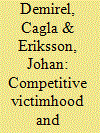

|
|
|
|
|
| Summary/Abstract |
This paper argues that conflicts tend to be intractable if collective victimhood has become a component of national identity, and when conflicting communities claim to be the ‘real’ or ‘only’ victims, and that their suffering justifies crimes past and present. Turkish and Armenian narratives of competitive victimhood are analysed drawing on public opinion polls from Turkey and Armenia, and personal interviews with Turks and Armenians. The study corroborates past theory and research that competitive victimhood prevents reconciliation, particularly if it has become an essential part of national identity. The paper also shows that Turkish–Armenian relations remain at the bottom stage of the reconciliation ladder. Yet, some of our empirical observations suggest that when grass-roots level interaction between Turks and Armenians is facilitated (which has been prevented not least because of the closed border), there is room for the abandonment of competitive victimhood at least on an interpersonal level, if not on a general societal or political level.
|
|
|
|
|
|
|
|
|
|
|
|
|
|
|
|
| 5 |
ID:
105993
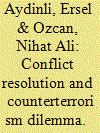

|
|
|
|
|
| Publication |
2011.
|
| Summary/Abstract |
This article considers the relationship between two processes-conflict resolution and counterterrorism-which conceptually share many common points, yet in practice do not necessarily proceed together easily towards a common goal. Considering particular cases of ethnic conflict in which terrorist factions exist, the article argues that while neither conflict resolution nor counterterrorism alone can adequately address the problem, simultaneously conducting both must keep in mind the processes' inherent differences and avoid excessive prioritizing of one over the other. By exploring recent Turkish governmental initiatives to address the Kurdish question, the article attempts to provide an outline for how to successfully cope with the two processes simultaneously.
|
|
|
|
|
|
|
|
|
|
|
|
|
|
|
|
| 6 |
ID:
101825
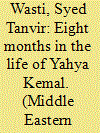

|
|
|
|
|
| Publication |
2011.
|
| Summary/Abstract |
With the end of British rule in the Indian sub-continent in 1947 and the establishment of the new state of Pakistan, the traditionally close relations between the Turks and the Indian Muslims were consolidated with the appointment of Turkey's senior poet-diplomat, Yahya Kemal Beyatli, as the first Ambassador of the Republic of Turkey to Pakistan. The ageing Ambassador filled this position for eight months under difficult circumstances until after the death of the founder of Pakistan, Mohammed Ali Jinnah. Based on Yahya Kemal's letters and other available information, the article attempts to capture the atmosphere surrounding Yahya Kemal's sojourn in Karachi.
|
|
|
|
|
|
|
|
|
|
|
|
|
|
|
|
| 7 |
ID:
125300
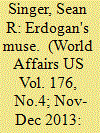

|
|
|
|
|
| Publication |
2013.
|
| Summary/Abstract |
On May 28th, around the same time Turkish Prime Minister Recep Tayyip Erdogan addressed the Justice and Development Party (AKP) delegation in Parliament, as he does most Tuesdays, police were ejecting protesters from Istanbul's Gezi Park. The previous day, environmentalists had begun gathering there to protest the cutting down of trees to make room for the reconstruction of the Halil Pasha Artillery Barracks, which stood on the same plot of land from the early 1800s until 1940. By the end of the week, the protests had grown in intensity, with over a hundred thousand demonstrators and police using tear gas and water cannons to control them. Clashes with police spread from the adjacent Taksim Square to other parts of the city, and later to eighty of Turkey's eighty-one provinces, with more than two million people participating in a movement that by the end of June left five dead and thousands injured. Istanbul alone suffered tens of millions of dollars worth of property damage.
|
|
|
|
|
|
|
|
|
|
|
|
|
|
|
|
| 8 |
ID:
120750


|
|
|
|
|
| Publication |
2013.
|
| Summary/Abstract |
As political trust literature has focused on its political and economical determinants, the linkage between ethnicity and trust in domestic and international institutions has been largely overlooked with a few notable exceptions. This study aims to underline this linkage and offer several hypotheses to test them in Turkish context. Using the European Social Survey conducted in 2008, this study finds that, though Kurds have low levels of trust in domestic institutions, their distrust is not uniform across all institutions. Second, it finds that Kurds are pro-international institutions; that is, compared to Turks, they hold higher trust in international institutions. Finally, it finds that, contrary to the studies on the winner/loser debate in long-standing democracies, winners in general and Kurdish winners, those who voted for the Justice and Development Party, the winning party in the 2007 election-are not distinguishable in their level of trust in political institutions from the rest of society.
|
|
|
|
|
|
|
|
|
|
|
|
|
|
|
|
| 9 |
ID:
001642
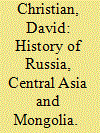

|
|
|
|
|
| Publication |
Oxford, Blackwell Publishers, 1998.
|
| Description |
xxiii, 470p.: plates, figures, maps, table.Hbk
|
| Series |
Blackwell History of the World (HOTW)
|
| Contents |
V.I: Inner Eurasia from prehistory to the Mongol empire
|
| Standard Number |
0631183213
|
|
|
|
|
|
|
|
|
|
|
|
Copies: C:1/I:0,R:0,Q:0
Circulation
| Accession# | Call# | Current Location | Status | Policy | Location |
| 041258 | 947/CHR 041258 | Main | On Shelf | General | |
|
|
|
|
| 10 |
ID:
089356


|
|
|
|
|
| Publication |
2009.
|
| Summary/Abstract |
The consolidation of the Delhi Sultanate coincided with the Mongol devastation of Transoxiana, Iran and Afghanistan. This paper studies the Persian literature of the thirteenth and fourteenth centuries invested as it was in the projection of the court of the Delhi Sultans as the 'sanctuary of Islam', where the Muslim community was safe from the marauding infidel Mongols. The binaries on which the qualities of the accursed Mongols and the monolithic Muslim community were framed ignored the fact that a large number of Sultanate elites and monarchs were of Turkish/Mongol ethnicity or had a history of prior service in their armed contingents. While drawing attention to the narrative strategies deployed by Sultanate chroniclers to obscure the humble frontier origins of its lords and masters, my paper also elaborates on steppe traditions and rituals prevalent in early-fourteenth-century Delhi. All of these underlined the heterogeneity of Muslim Sultanate society and politics in the capital, a complexity that the Persian litterateurs were loath to acknowledge in their records.
|
|
|
|
|
|
|
|
|
|
|
|
|
|
|
|
| 11 |
ID:
162782
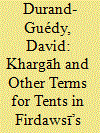

|
|
|
|
|
| Summary/Abstract |
This article aims to contribute to the wider debate on the historicity of the Shāh-nāmah by focusing on the way Firdawsī uses the word khargāh. The word, which is first attested in Rūdakī poetry, has not been dealt with adequately in previous scholarship dedicated to the Shāh-nāmah. An analysis of all the occurrences in the text provides results consistent with those obtained from contemporary sources: the khargāh appeared in Central Asia (here, Tūrān); it was the standard dwelling of Turkic-speaking pastoral nomads (here, Tūrānians), whatever their social rank; and it was adopted later as a status symbol by non-Turkish elites (here, during Kay-Khusraw’s reign). In Firdawsī’s Shāh-nāmah khargāh should therefore also be understood as the type of framed tent known as “trellis tent” (the so-called yurt).
|
|
|
|
|
|
|
|
|
|
|
|
|
|
|
|
| 12 |
ID:
128222
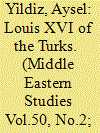

|
|
|
|
|
| Publication |
2014.
|
| Summary/Abstract |
Selim III ruled the Ottoman Empire in the Age of Revolutions, but his rule did not reflect the vigorous, expansionist and aggressive spirit of this age. He more resembled a ruler forced to defend his empire from the turbulence of the age, an effort which also shaped his character and perception of rulership. During his years in royal confinement, he clung passionately to the revival of the warrior-sultan through charismatic leadership. While on the throne, there was a gradual transformation of his perception of rulership and he became satisfied with being the bureaucratic ruler of the empire.
|
|
|
|
|
|
|
|
|
|
|
|
|
|
|
|
| 13 |
ID:
100736
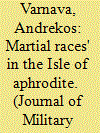

|
|
|
|
|
| Publication |
2010.
|
| Summary/Abstract |
In the nineteenth century European powers employed "natives" perceived to be inherently "martial" as the mainstay of their imperial armed forces. This theory of "martial races" undergirded the composition, for example, of Britain's Indian Army. An attempt in the 1890s to apply "martial races" theory to the formation of an indigenous defence force in Cyprus, however, proved to be an unqualified failure. Although the British government claimed that the scheme fell through because of inadequate funds, the main reason was that the decision to recruit the force exclusively from among the presumably more "martial" Turkish Muslim population of the island contradicted local ideas of identity by dividing Cypriots into "Greeks" and "Turks," with unhappy consequences for the future.
|
|
|
|
|
|
|
|
|
|
|
|
|
|
|
|
| 14 |
ID:
139126
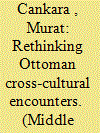

|
|
|
|
|
| Summary/Abstract |
This article aims to show how and why Armeno-Turkish, or Ottoman Turkish written in Armenian letters, especially throughout the nineteenth century, was not merely an Armenian phenomenon but rather a cultural reflection of a larger Ottoman history. The article begins with a critique of the literature on the Ottoman millets and the interaction among them. It then presents examples of Turkish statesmen, authors, and journalists who were either aware of or could read Armeno-Turkish, and explores how Armeno-Turkish might have served as a written lingua franca among the members of different ethnic, religious, and linguistic groups in the Ottoman Empire. Finally, it concludes with a number of reflections on the possible reasons for Turksʼ interest in the Armenian script. The article thus aims to contribute to the debate over the Ottoman millet system from the perspective of cross-cultural exchanges and encounters among the different peoples of the Ottoman Empire.
|
|
|
|
|
|
|
|
|
|
|
|
|
|
|
|
| 15 |
ID:
097787
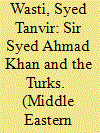

|
|
|
|
|
| Publication |
2010.
|
| Summary/Abstract |
Sir Syed Ahmad Khan was a pioneer of higher education for the Muslims of India after political power passed to the British in the nineteenth century. He was a leader who foresaw with clarity that Hindus and Muslims were bound to seek separate national destinies after the British left India. After the collapse of their own empire, the Indian Muslims aligned themselves with the Ottoman Turks and Sir Syed therefore deliberately chose Turkish models for educational, cultural and even sartorial reform. He was loyal to British rule in India mainly because, though it subdued all Indians, it simultaneously prevented the Hindu domination of Muslims.
|
|
|
|
|
|
|
|
|
|
|
|
|
|
|
|
| 16 |
ID:
128031
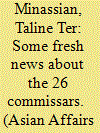

|
|
|
|
|
| Publication |
2014.
|
| Summary/Abstract |
One of the great founding legends of Soviet Union is that of the murder in September 1918 of 26 Soviet Commissars in Transcaspia, allegedly by a British officer, Reginald Teague-Jones. The episode which became the legend took place at the end of the First World War, at the very end of the eastern front, where the Russian withdrawal from the war left a vacuum and a situation which was confused, to say the least. Independent Soviets were springing up and one of these was the short-lived Baku Commune (also mythologised by the Soviets) When the Commune collapsed its leaders, the 26 Commissars, were imprisoned. Weeks later, in the confusion of the capture of Baku by the Turks, the Commissars escaped by boat, bound for Astrakhan, then held by the Bolsheviks. But they ended up in Krasnovodsk, in the hands of the anti-Bolsheviks and they were subsequently executed. Limited British forces (Malmiss and Dunforce) were in the area. They were initially deployed against the Turks, who were fighting on the German side, but then the Bolsheviks became the primary concern for the British. It is clear that Teague-Jones had a liaison role with the anti-Bolsheviks, but modern evidence suggests that it is very unlikely that he was even present at the execution of the 26 Commissars. The article shows how the legend grew and why the involvement of an agent of British Imperialism fitted a propaganda need.
|
|
|
|
|
|
|
|
|
|
|
|
|
|
|
|
| 17 |
ID:
054129
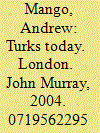

|
|
|
|
|
| Publication |
London, John Murray, 2004.
|
| Description |
xii, 292p.hbk
|
| Standard Number |
0719562295
|
|
|
|
|
|
|
|
|
|
|
|
Copies: C:1/I:0,R:0,Q:0
Circulation
| Accession# | Call# | Current Location | Status | Policy | Location |
| 048700 | 956.103/MAN 048700 | Main | On Shelf | General | |
|
|
|
|
|
|
|
|
|